Inside the Nomadic Wonders of Nepal
discover a special way of life, rich traditions, and captivating stories that make the Raute people unique.

Get ready to discover a special way of life, rich traditions, and captivating stories that make the Raute people unique. From their nomadic lifestyle to age-old customs. Who are the Rautes? What makes them who they are?
Get ready to discover a special way of life, rich traditions, and captivating stories that make the Raute people unique. From their nomadic lifestyle to age-old customs. Who are the Rautes? What makes them who they are? As we venture into the remote corners of Nepal to witness the Raute's distinctive way of life, their ancient customs, and the fascinating stories that make them a living testament to the diversity of our world
Introduction
The Raute People of Nepal are a unique and nomadic ethnic group officially recognized by the government. They are known for their traditional way of life, which involves hunting langurs and macaque monkeys, as well as collecting wild forest tubers, fruits, and vegetables. Instead of selling forest products, bushmeat, or medicinal plants, they engage in wood carving to trade for essentials like rice, iron, cloth, and jewelry with local farmers. These people live in the western mountains of Nepal, ranging from 2,000 to 10,000 feet above sea level. They go up the mountain in the summer and come down in the winter.
With a population estimated around 650, the Raute People, as of the 2011 census, have small settlements in western Nepal. Despite government efforts to settle them, about 150 of them still prefer a nomadic lifestyle. This choice often leads to conflicts, as they move from place to place, cutting small trees in state-owned forests for their tents. Nomadic Rautes have a strong sense of attachment with the Forest. Additionally, the Raute People keep their language, hunting strategies, and worship practices private to preserve their cultural purity.
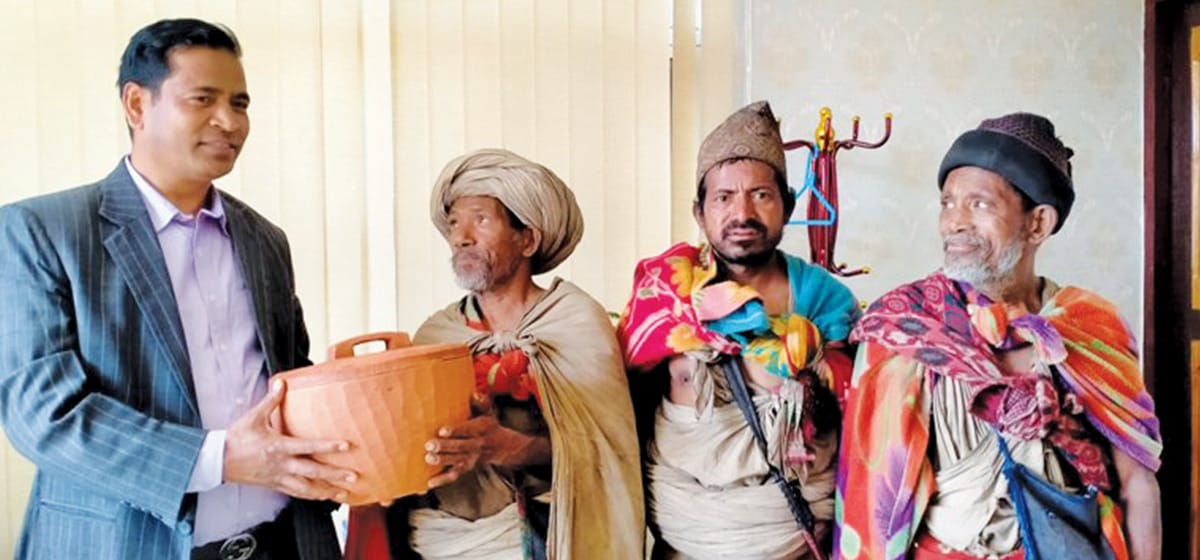
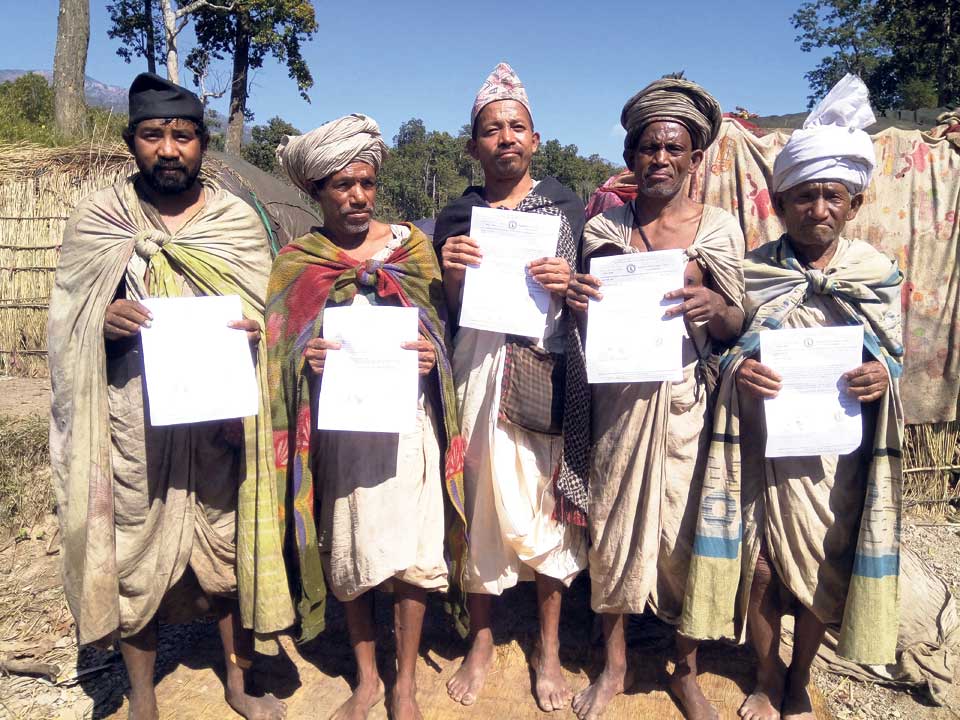
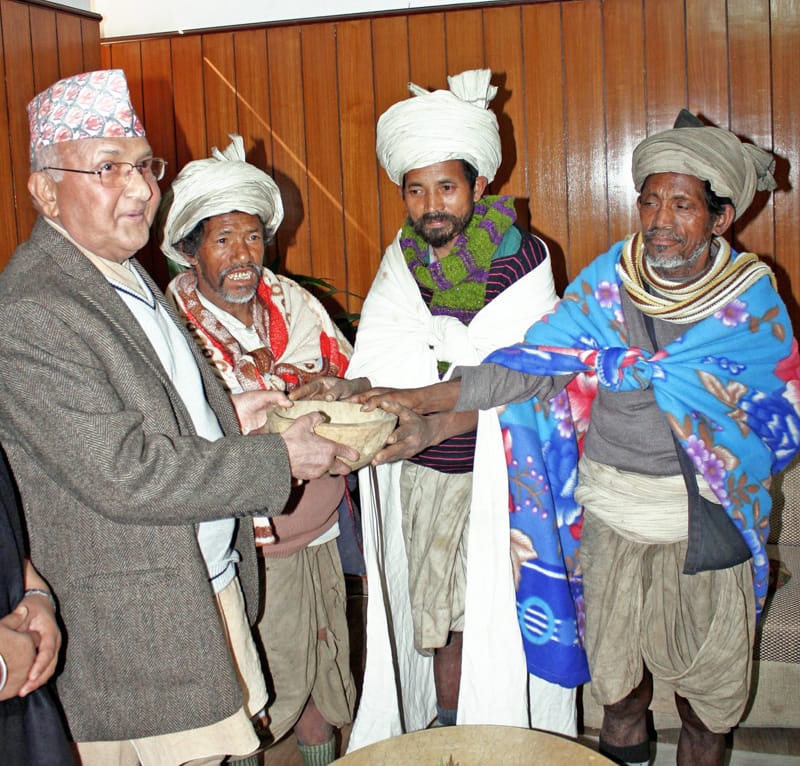

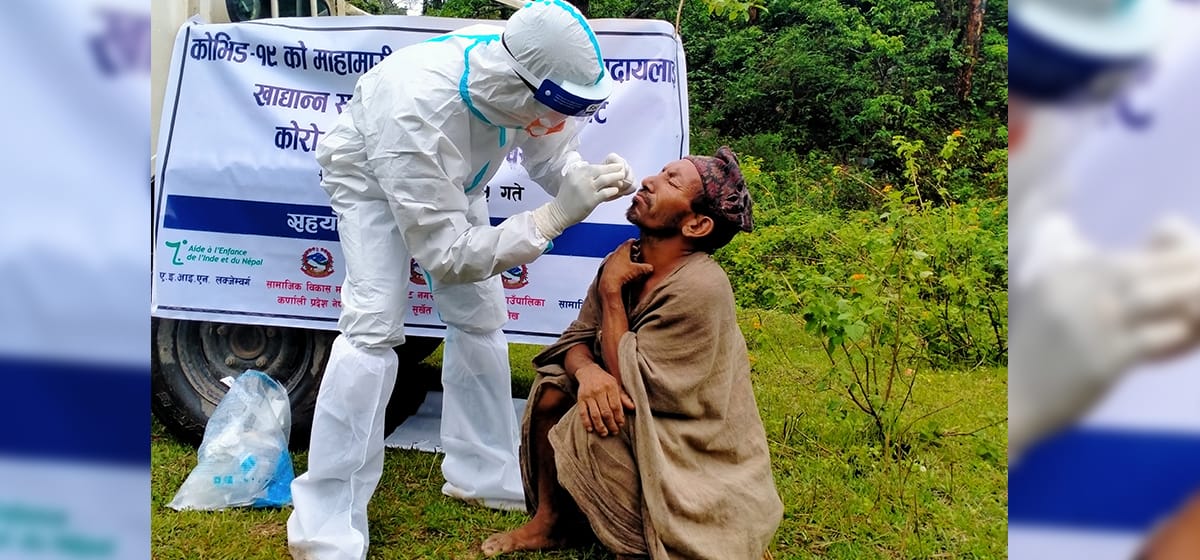
Raute people involvement in different government activities
Rautes relation with government of nepal
The Raute People faced a significant change in 1979 when the government forcefully relocated them from the Darchula District to the middle highlands of Dadeldhura. Although they were given land, much of it was taken away by wealthier landowners, prompting many Raute to return to the forest. Changing living arrangements and locations led to some of them adopting new names and intermarrying with neighboring ethnic groups although it is considered going against their culture. But due to the circumstances, there are few Raute people that are seen doing so. In Jajarkot, there still are Raute individuals who have intermarried with the surrounding Kami and Damai castes.
Despite negative sentiments from some locals, the political landscape of the Raute People is intricate. The government currently provides financial support and land to the Raute family. Every Raute receives Rs 2,000 per month from the fund, and the federal government also grants Rs 3,000 to each Raute as a social security allowance. The amount provided by the provincial government, however, is intended for daily essentials and housing facilities. The Raute people follow a form of animism as their religion, and there are no known Christians among them.
The route of raute
Most Raute People reside in the Dadeldhura District, with smaller populations in the Surkhet and Dang Districts. They move across western Nepal, maintaining their nomadic lifestyle and the Raute language, which is classified as Sino-Tibetan, Tibeto-Burman, Western Tibeto-Burman, Himalayan, Central Himalayan, and Raute-Raji-Rawat. However, more research is needed to understand these linguistic connections fully. The Raute People continue to embrace their identity as full-time foragers, resisting assimilation into the surrounding agricultural population.
Lifestyle
The Raute People's way of life revolves around certain beliefs that impact their involvement in education and agriculture. They still face limitations in these areas, and they persistently refrain from engaging in agricultural activities. For the Raute, planting seeds is considered a sin, and both agriculture and animal husbandry are strictly forbidden within their cultural practices.
In order to sustain themselves, the Raute People follow a distinctive approach. Instead of cultivating crops or raising animals, they rely on their skills in crafting wooden goods. These items, such as bowls and boxes, are then exchanged for food grains with local farmers. This unique economic system allows them to obtain essential food resources without participating in farming or animal-related activities.
Interestingly, the Raute People do not show interest in pursuing various professions or occupations beyond their traditional wooden craftsmanship. They firmly believe that education holds no value for them, and as a result, they choose not to pursue formal education. Their focus remains on preserving their distinct way of life, where the exchange of wooden goods for food grains serves as their primary means of survival.
The Raute People obtain their food by gathering various items from the forest. These include yams, roots, berries, and other natural foods. Interestingly, although they don't fish, there's no rule against eating fish if they choose to do so.
In the Raute community, the tasks people do are divided based on gender. Women typically handle activities like cooking, washing utensils, fetching water from the stream, and processing grains by beating them. On the other hand, men are responsible for different tasks such as carving wooden vessels, gathering wood from the bush, selling wooden goods, trading them for grains, and engaging in the hunting of monkeys. This division of labor helps organize their daily activities and contributes to the functioning of the community.
The Raute People have become skilled in the practice of hunting monkeys, and they've even created a special net for this purpose. When it comes to monkey hunting, it's a collaborative effort involving a group of men from the community working together. They have a unique method and tools specifically designed for catching monkeys.
Interestingly, their focus is mainly on hunting monkeys, and they don't show much interest in hunting birds or other animals. This specialization in monkey hunting showcases their expertise in this particular skill, which plays a significant role in their way of life.
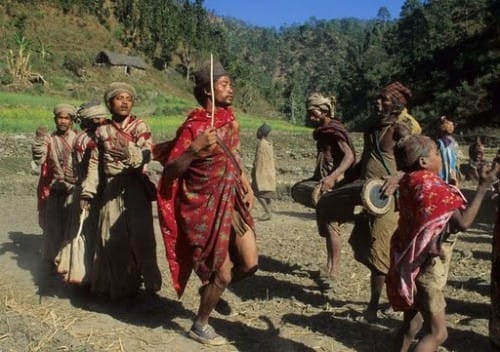
Practices and Rituals
In the Raute community, they follow a practice known as endogamy, which means they prefer to marry within their own group. Additionally, after their marriage, the newlywed couple moves to a new tent to start their married life, even if it means leaving behind their bereaved mother and sister. Interestingly, they don't base their lineage on names, gods, or inherited property. Even though they don't practice polygamy, men who have lost their wives are allowed to marry again. However, widows, which are women who have lost their husbands, are not permitted to remarry.
It's important to note that the Raute People strongly discourage two specific types of marriages. Firstly, they don't approve of inter-caste marriages, which means marrying someone from a different social group. Secondly, child marriages are strictly forbidden within their culture. This means that they are against young individuals getting married at an early age. These cultural norms shape the way marriages and relationships are approached in the Raute community.
The Raute People in Nepal have a unique way of worshiping, focusing on natural elements like the sun, rivers, and forests. They hold Bhuyar, the hunting god, in high regard and conduct religious rituals dedicated to Bhuyar. Interestingly, only men participate in these religious activities, and there's a belief that outsiders should not come into contact with Bhuyar.
When a member of the Raute community passes away, they follow the practice of burying the body in a nearby forest. After this, they swiftly move their camps to a new location. To sustain themselves everywhere they go, they just do the same thing everywhere, they cut down soft trees to carve wooden vessels, which they then trade for grains with local farmers. This unique method of living allows the trees to regrow as they relocate.
The Raute People have specific preferences in their daily life, such as drinking water only from natural springs. They avoid water sources like ponds, hand pumps, or wells.
Living a nomadic life, the Raute People have a belief rooted in a story from their history. They think that staying in one area for a long time brings bad luck, as one of their family members died under such circumstances. Therefore, they avoid staying in one place for an extended period.
In terms of the language they use to communicate, Raute people not only speak their native Raute language but also communicate in Nepali and Dotyali. But, Interestingly, Raute communities are not limited to Nepal; they can also be found in Bangladesh. It is suggested that there might be more Rautes in Bangladesh than in Nepal itself, although this has not been statistically proven.
There have been long-standing misunderstandings between the Rautes and the locals. Some people think the Rautes perform human sacrifices every twelve years, while others believe they might enchant and keep you prisoner if you enter their camp. These are just rumors, and there's been no evidence from outsiders to prove this.
Learn more
The evolving community
The lifestyle of the Raute People has changed over time. In the past, they used to trade their goods only for food, believing that counting money is a sin. Nowadays, things are different; they've started earning some money, and not only that, but they now ask for money when they meet the locals. Another noticeable change is in their attitude towards alcohol. In the past, Raute community members were seen as stubborn but clear-headed and innocent. However, nowadays, they are often observed being drunk, including children as young as 8 or 10 years old. This represents a shift from their traditional ways, as they are now frequently seen intoxicated, sometimes even getting into fights with locals at local hotels.
Conclusion
Putting it all together, the Rautes like keeping things mysterious, maybe to stay away from the outside world's influence. They're not big talkers, they avoid outsiders in their camp, and find quiet spots for their own world. Their life is puzzling; they wander around the edges of the world they've made, floating like clouds and feeling as free as birds. But there are conflicts with them in modern society.
The Raute elders think their old traditions will stick around, but how many generations can keep living like this? We'll have to wait and see.
It's important to note that the Raute People face challenges, and their population is decreasing. Therefore, there is a call from our side for the government to pay attention and take measures to preserve their culture, traditions, and beliefs, considering them as valuable assets for the country of Nepal.




